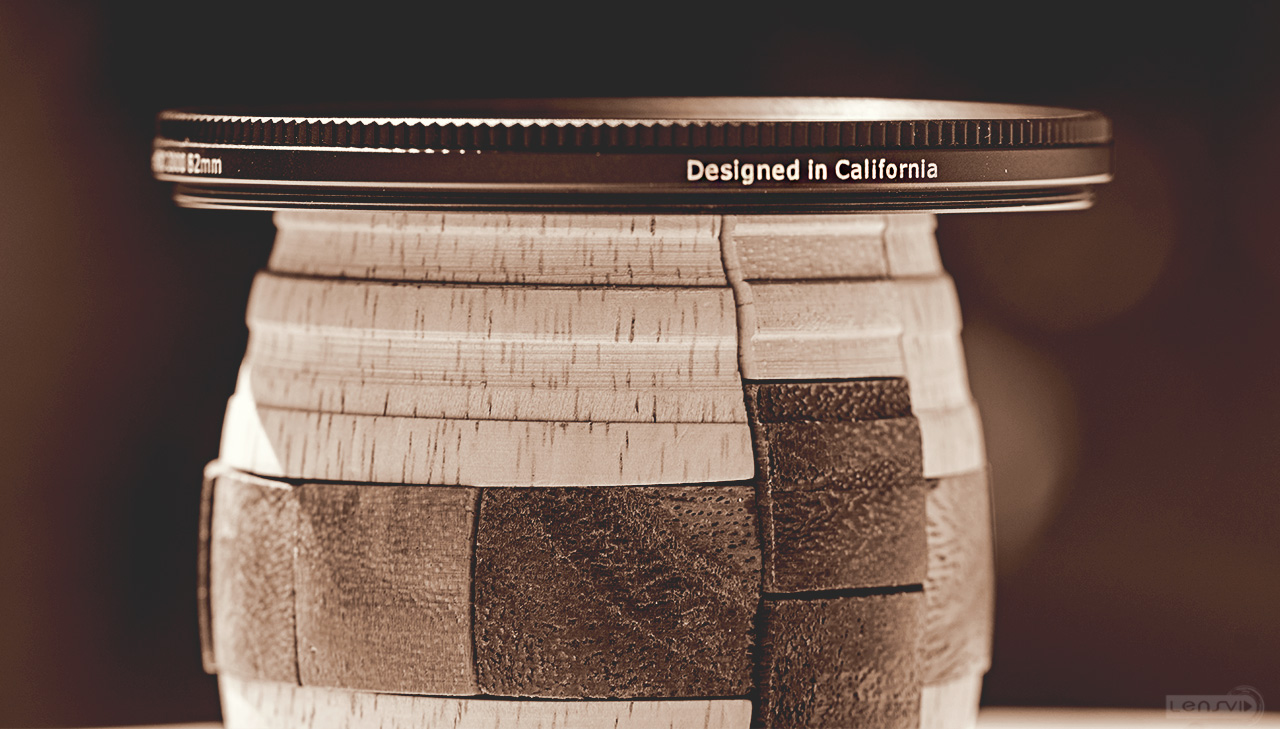Earlier this year we received the most powerful variable ND filter currently on the market – the Aurora Aperture Power XND 2000 which boosts an unprecedented official 11 stops of light reduction capability – significantly more than any other similar product. After some very intensive testing and comparison we bring you our full review of this interesting product.
The Aurora Aperture Power XND 2000 started as a Kickstarter project (see our article here) and is currently on indiegogo. The idea behind this product is to try and bring a variable neutral density filter which will be as powerful as some of the strongest “normal” (non variable) ND filters out there (and before you run to write comments like I “but I have an ND6 filter with 20 f stops of light reduction – notice we wrote “some of the strongest ND filter out there”).
Why do you need such a strong light reduction? well – in our experience for very bright scenes in video (mid day, mid summer, full sunlight) some of the existing variable neutral density filters are not powerful enough (at least not without getting too close to their limits where you typically get tons of vignette and in some cases an X pattern which is common with variable ND filters). For long exposure in still it might also be a good option – although even what it can provide might not be enough in some situations.
Power XND 2000 – Really the most powerful variable ND?
Here are some official specs for the Aurora Aperture Power XND 2000:
- Has 11 stops (ND 2000) of light reduction capability.
- Built from aerospace grade aluminum with CNC.
- Slim profile of 5.5mm.
- Has multiple layers of nano coating for anti-reflection purposes and to protect filter surface from dust, water, oil, and soil contaminations.
- Filter sizes 37mm, 39mm, 40.5mm, 43mm, 46mm, 49mm, 52mm, 55mm, 58mm, 62mm, 67mm, 72mm, 77mm, 82mm, 86mm, 95mm, and 105mm (some of these are new).
Before we start a word about terminology – for some ungodly reason over the years different notations and rating methods were developed for ND filters. We think that the simplest is just stating how much light the filter reduce in f-stops (ND1 notation), but there are at least two other notations which you can read about in this wiki table under “ND filter ratings”). Just know that the Aperture Power XND 2000 – is, unsurprisingly an ND2000 capable filter (officially).
Design and build
We shall start this review with a look at the physical construction of the Power XND 2000. We got the unit in a simple plastic box with nothing but the filter inside – very Spartan compared to the Syrp filter which you get with a round cardboard box and a nice case and some cleaning fabric.
Packaging aside, the Power XND 2000 seems well made – nothing seems loose and the filter moves very smoothly (we would say that it is a bit smoother than the Syrp).
The Power XND 2000 is also very thin around 7.8-7.9mm vs. 8.3-8.2mm for the Syrp (which is not considered thick either), both with the lips of course.
Maybe the most distinctive external feature of the Power XND 2000 is the groves that helps you rotate the filter – they are relatively deep and feel very good in the hand (and as we mentioned the rotation itself is very smooth).
The grooves on the Power XND 2000 – very easy to turn
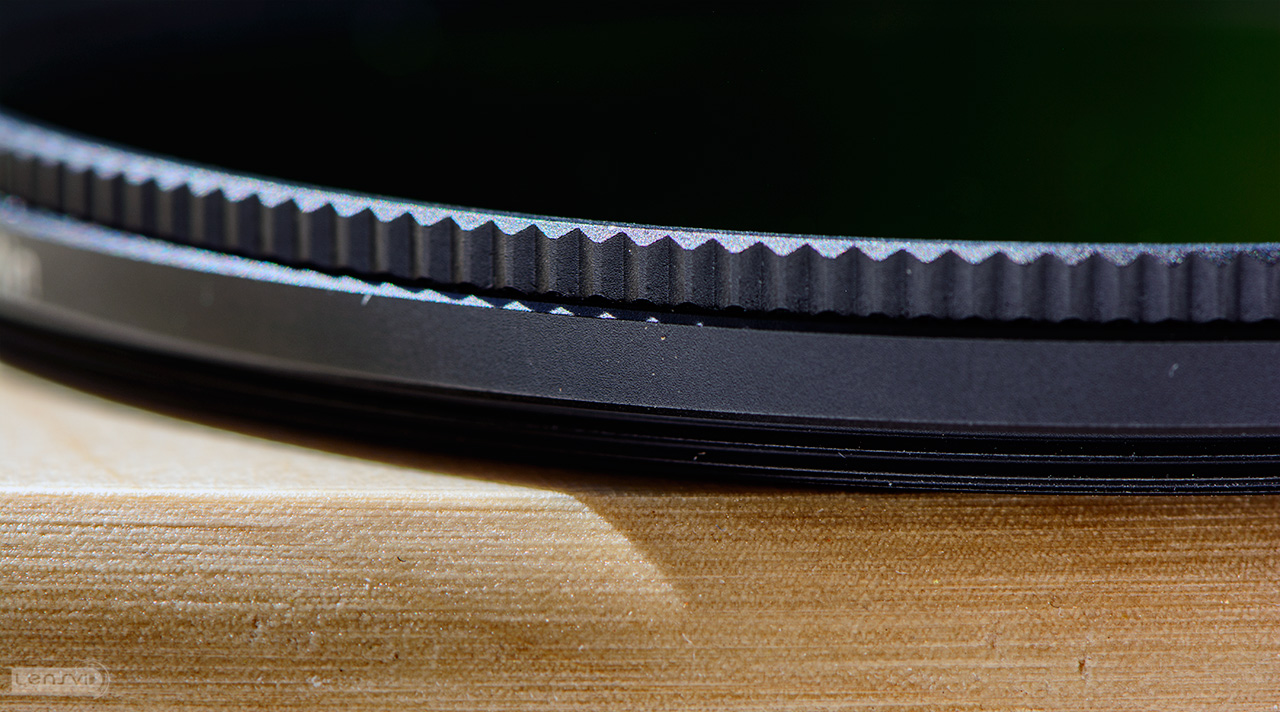 The only minor downside of the Power XND 2000 construction are the markings – we have mentioned this on the Syrp review as well but we would really like to see linear markings on a filter (we will talk about the linear aspect later on in this review). The Power XND 2000 has small dots on the side – don’t be fooled – they do not signify f-stops (they actually do not even signify exact light reduction – we mentioned that the filter is non linear so a big change in the start might not make any difference while a small change near the end might reduce the light dramatically). The Syrp also has this issue but it has lines (similar to I, II, III, IIII etc.) which we find easier to read and repeat – just numbers would probably be better.
The only minor downside of the Power XND 2000 construction are the markings – we have mentioned this on the Syrp review as well but we would really like to see linear markings on a filter (we will talk about the linear aspect later on in this review). The Power XND 2000 has small dots on the side – don’t be fooled – they do not signify f-stops (they actually do not even signify exact light reduction – we mentioned that the filter is non linear so a big change in the start might not make any difference while a small change near the end might reduce the light dramatically). The Syrp also has this issue but it has lines (similar to I, II, III, IIII etc.) which we find easier to read and repeat – just numbers would probably be better.
Update: Aurora Aperture told us that the unit that we tested is actually a pre-production version and that they will be looking at a different marking method for the final version (it will have a few other minor changes including a thicker plastic case).
Performance
Now we reach the most important part in this review – how the Power XND 2000 perform. First we want to say that accurate filter testing is a torturous task and testing such a high ND filter requires a LOT of light so the only real way of testing it is mid day outside on a very sunny day (which is typically also very hot – especially here in Israel). On top of all that we had to repeat some of the testing no less than 4 times due to all sort of strange results (as well as some errors in testing on our part – just try doing these complex tests in the scorching heat over and over and see if you get it 100% right the first time…).
Light reduction – We will cover this more in our distinction later on but the bottom line is that the Power XND 2000 was able to reduce 9.6 stops of light (the official number is 11) compared to the correct exposure without any filter. As we shall see in a second this isn’t the entire story and out of this 9.6 stops you would probably only want to use about 7.5 stops (but this is us – you might be O.K. with more – or less depending on what you shot and your personal preferences).
Sharpness – When it comes to sharpness the Power XND 2000 really shines – we thought that the Syrp was a sharp filter, but when we compared them the Power XND 2000 was visibly sharper as you can see from the images below.
The two filters on the minimum ND setting (note the strange blue cast of the Power XND 2000 – it was completely gone the next day…bizarre) – click to enlarge
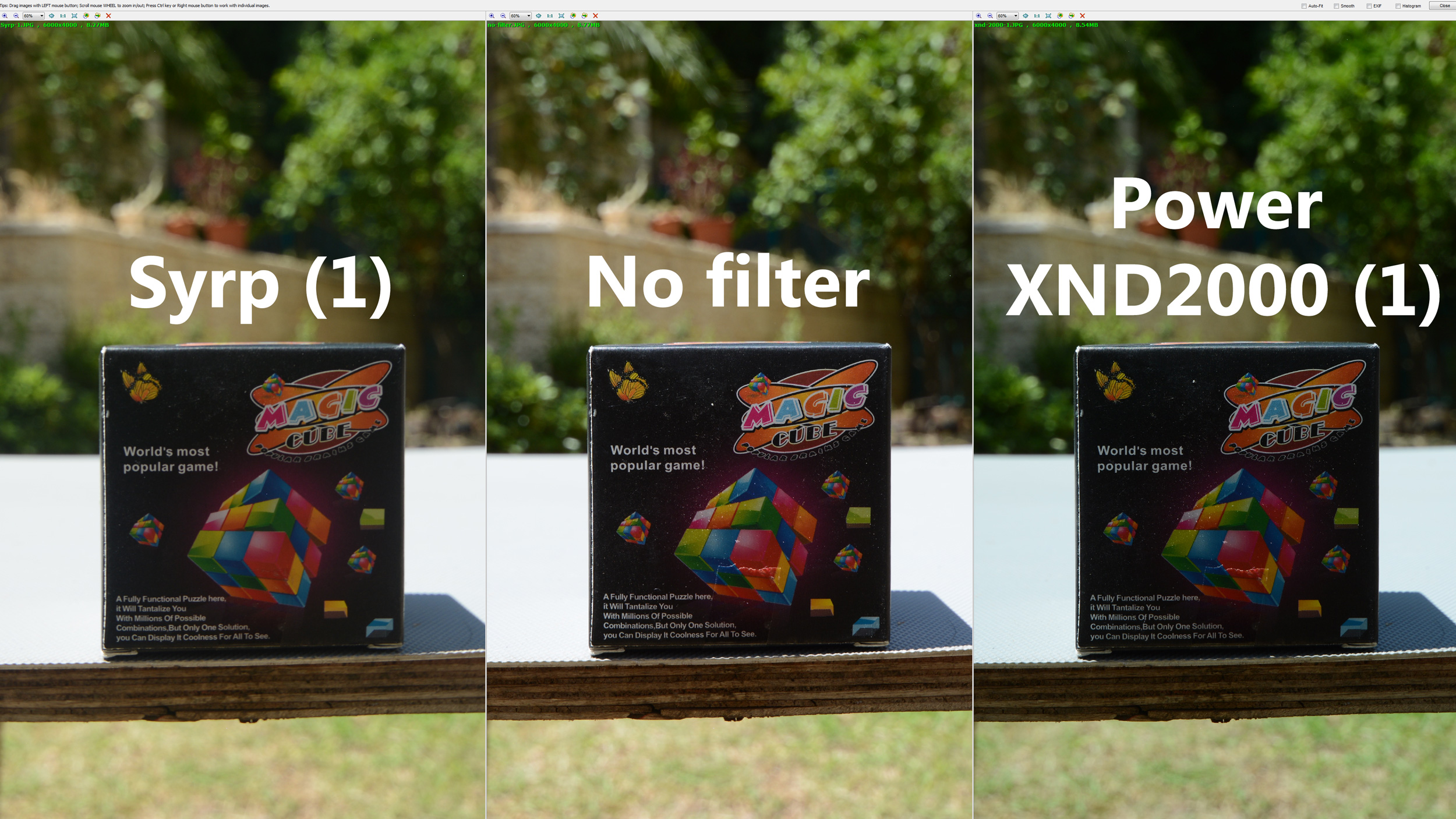 The two filters at close to the max ND – click to enlarge
The two filters at close to the max ND – click to enlarge
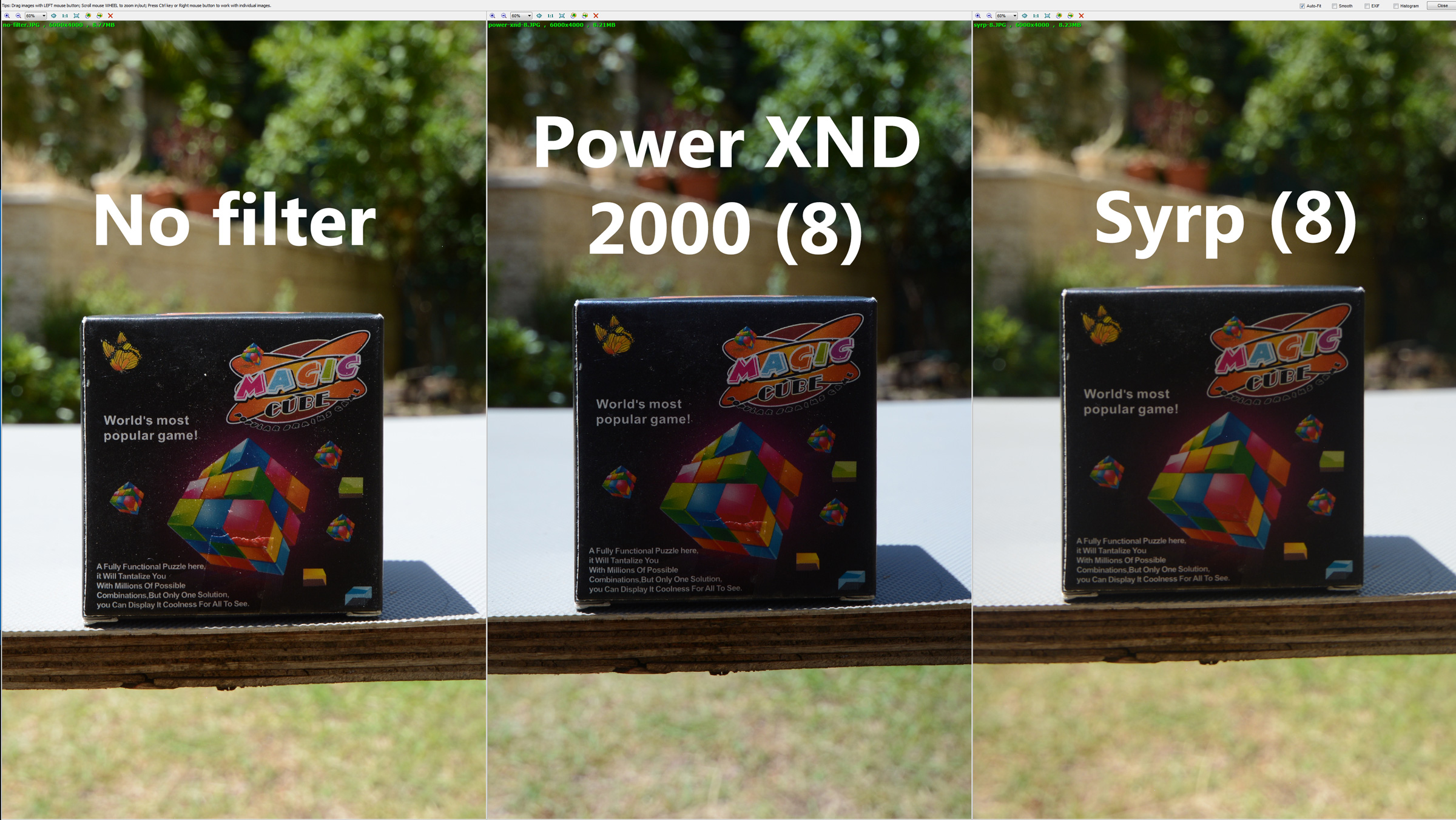 Vignette – If sharpness is the strong side of the Power XND 2000, than vignette is the weaker part. It has visibly more vignette all thorough the range (to be fair it does reduce the light much more than the Syrp). The only place where the Power XND 2000 is better is at max ND where the Syrp just falls apart with some serious color issues (however in our opinion at max, both filters are completely unusable).
Vignette – If sharpness is the strong side of the Power XND 2000, than vignette is the weaker part. It has visibly more vignette all thorough the range (to be fair it does reduce the light much more than the Syrp). The only place where the Power XND 2000 is better is at max ND where the Syrp just falls apart with some serious color issues (however in our opinion at max, both filters are completely unusable).
Vignette test at min level
 Close to the max limit – both filters show quite a bit of Vignette
Close to the max limit – both filters show quite a bit of Vignette
 At the max limit both filters are not exactly usable in our view
At the max limit both filters are not exactly usable in our view
 X-factor – as you can see above the Power XND 2000 doesn’t show the X-pattern even at max – the Syrp does (most of the time). We actually don’t see this as anything too special because as we noted above – at max both filters are not usable due to vignette.
X-factor – as you can see above the Power XND 2000 doesn’t show the X-pattern even at max – the Syrp does (most of the time). We actually don’t see this as anything too special because as we noted above – at max both filters are not usable due to vignette.
The X-pattern on the Syrp filter (close to the 8.5 max level) we didn’t encounter this with the Power XND 2000
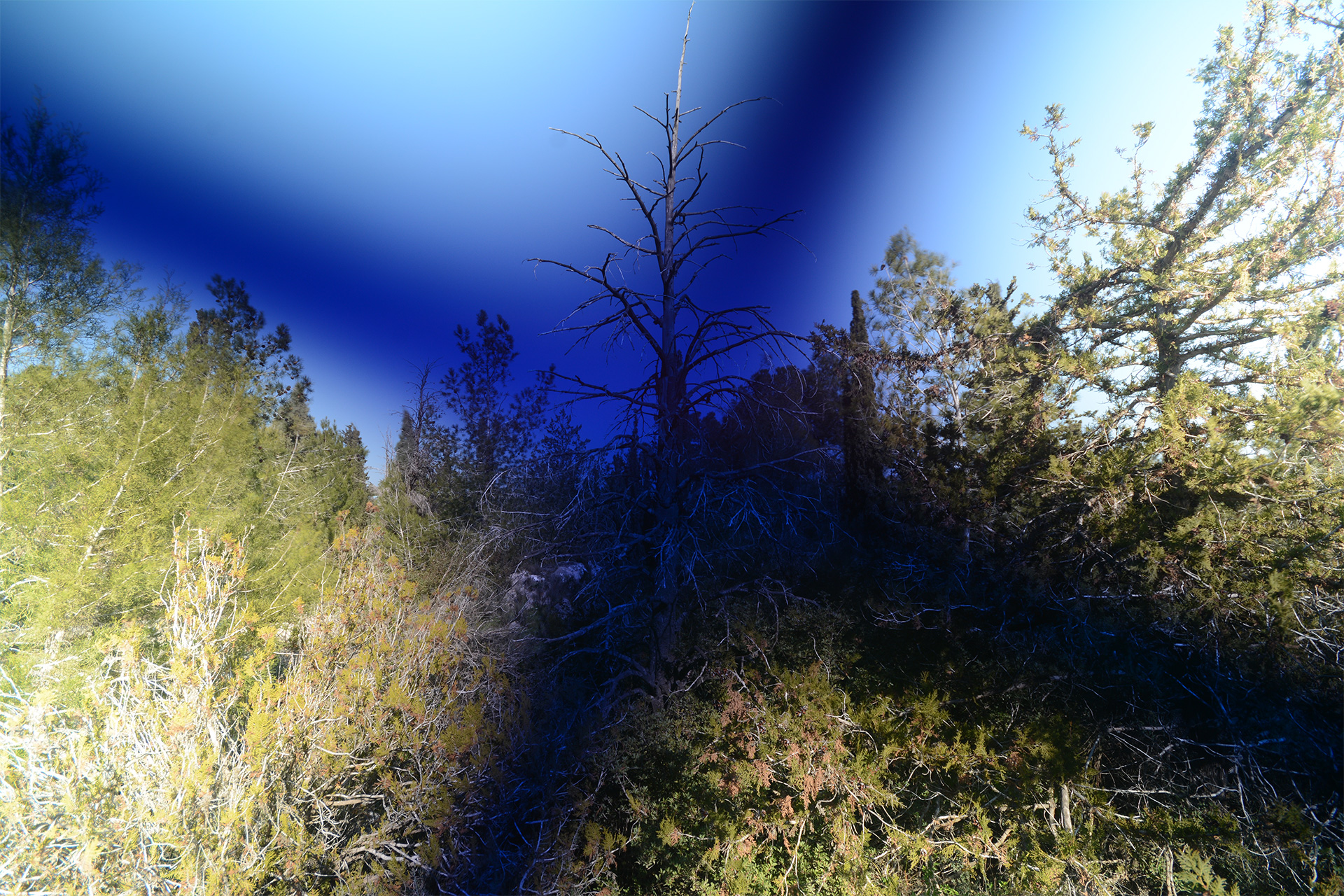 Colors – This was the most complex test of all. We has to repeat it as we mentioned multiple times as we got some very strange results (see the two images below). Finally after about four times we were able to produce a test procedure which was “stable enough” and repeatable enough where we got no visible light difference and no abnormalities (however we are going to continue looking into this and update this article in the future if needed).
Colors – This was the most complex test of all. We has to repeat it as we mentioned multiple times as we got some very strange results (see the two images below). Finally after about four times we were able to produce a test procedure which was “stable enough” and repeatable enough where we got no visible light difference and no abnormalities (however we are going to continue looking into this and update this article in the future if needed).
Notice the blue cast on the right – this happened on all the shots that day – but did not happen a day later
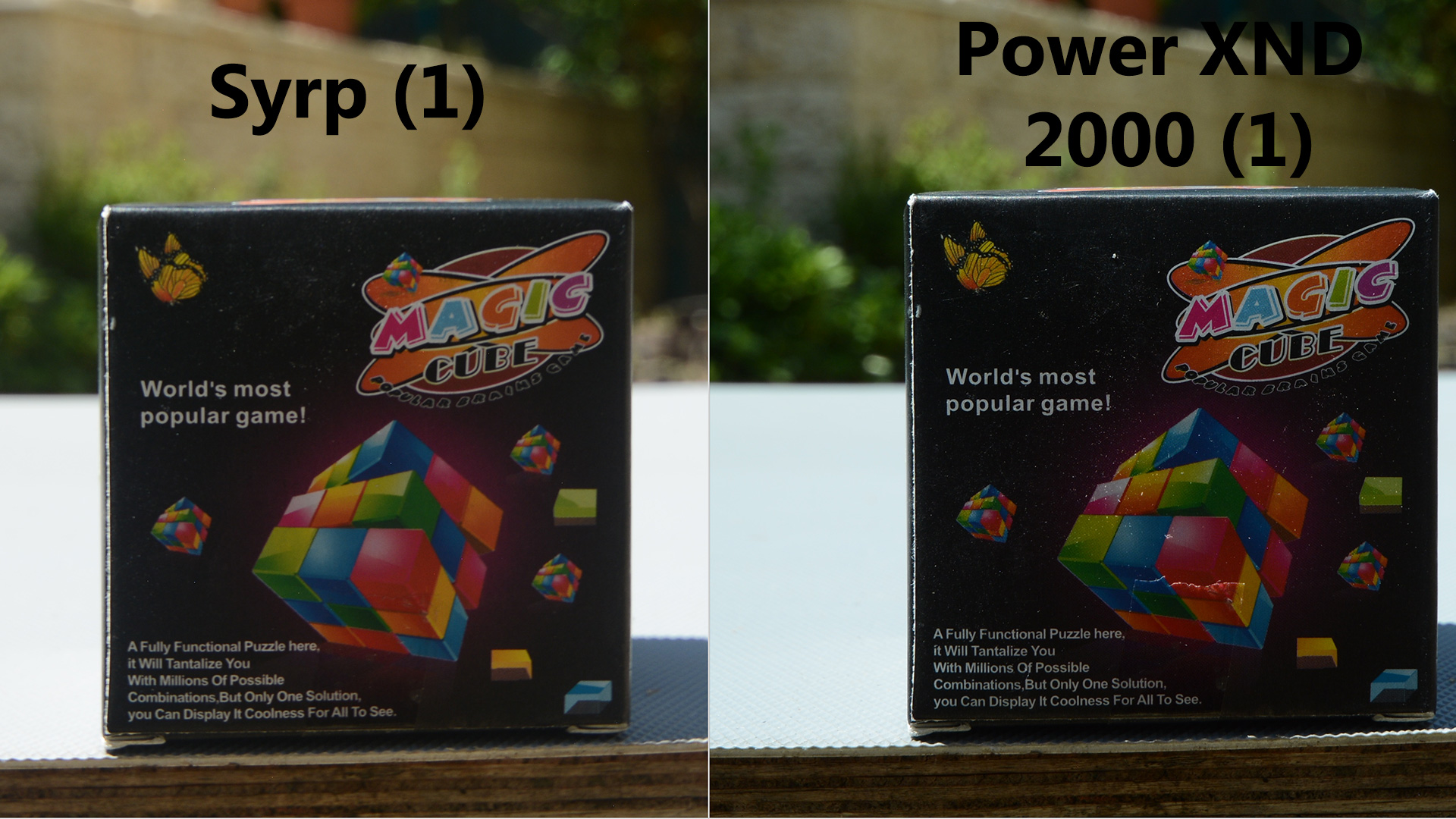 A very strange result with the Power XND 2000 at max – this didn’t happen again (maybe a ghost ran through our shot?)
A very strange result with the Power XND 2000 at max – this didn’t happen again (maybe a ghost ran through our shot?)
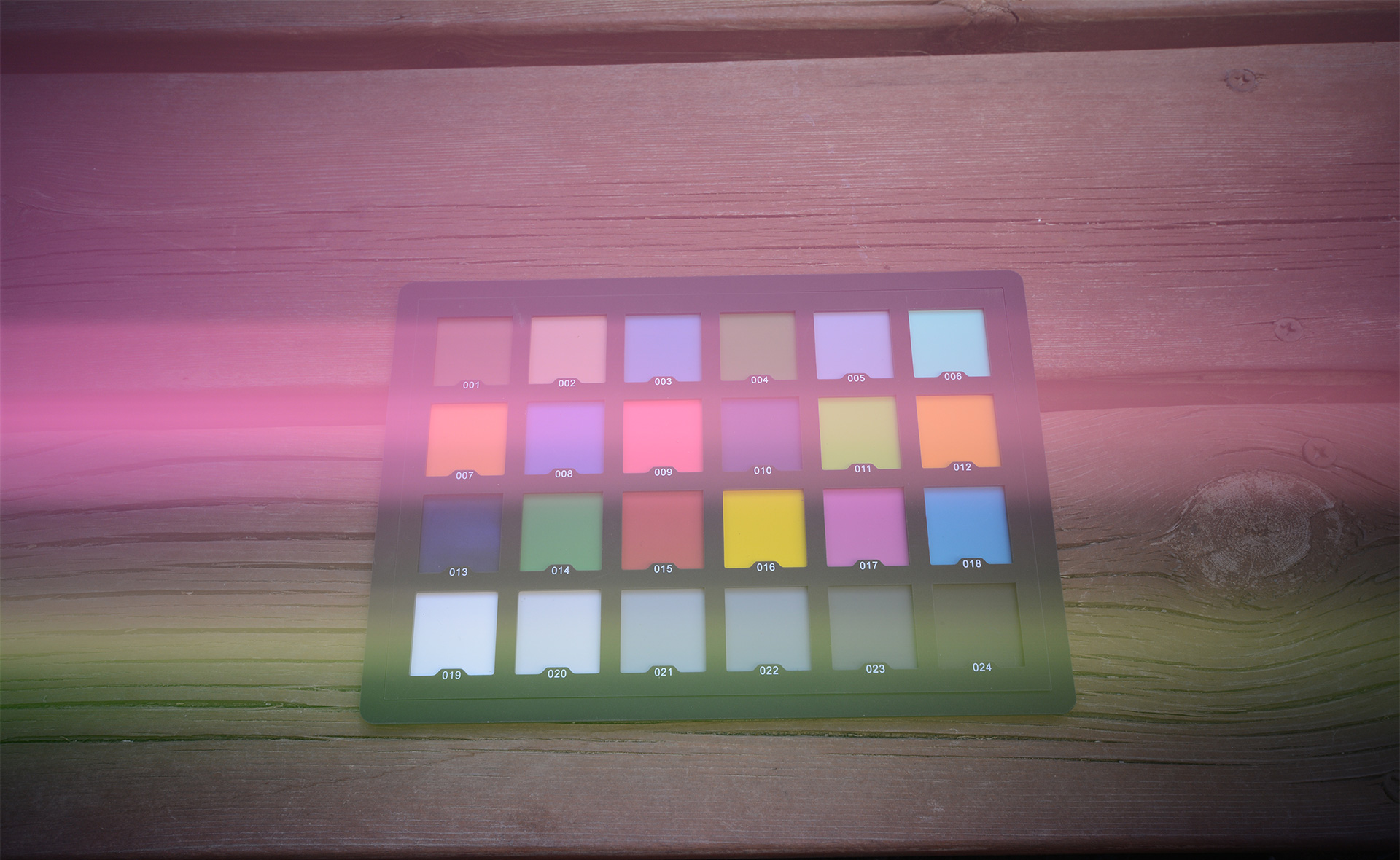 Our final color test min level – can you see a difference? click to enlarge
Our final color test min level – can you see a difference? click to enlarge
 Our final color test mid level – can you see a difference? click to enlarge
Our final color test mid level – can you see a difference? click to enlarge
 Our final color test max level – can you see a difference? click to enlarge
Our final color test max level – can you see a difference? click to enlarge
 Non linear ND – Just like the Syrp, the Power XND 2000 is not a linear variable ND filter. What this means is that the same amount of filter rotation doesn’t result in the same amount of light reduction when applied close to the minimum level of the filter vs. the maximum amount (on both filters you will see a lot more light reduction close to the maximum). We talked to the manufacturer and it seems that this is an inherent property of a variable ND filters in general (if you know the reason / or know otherwise – do let us know in the comments below). What you do need to know is not to expect a very precise correlation of light reduction between the dots on the side of the filter and the amount of light reduction you will actually get.
Non linear ND – Just like the Syrp, the Power XND 2000 is not a linear variable ND filter. What this means is that the same amount of filter rotation doesn’t result in the same amount of light reduction when applied close to the minimum level of the filter vs. the maximum amount (on both filters you will see a lot more light reduction close to the maximum). We talked to the manufacturer and it seems that this is an inherent property of a variable ND filters in general (if you know the reason / or know otherwise – do let us know in the comments below). What you do need to know is not to expect a very precise correlation of light reduction between the dots on the side of the filter and the amount of light reduction you will actually get.
Update – After talking to Aurora Aperture we learned something interesting that we didn’t know (you learn something new every day we guess). As they explained it to us: “The non linear scale [on the filter] comes from the fact that light stop by itself is not linear. Let’s say in a normal day we have f/8 and 1/100, one stop less is f/8 and 1/50 which is 50% less light, two stop less is f/8 and 1/25 which is 25% of the original light, and so on. So while we have the one, two, and three stops, the light being passed is 50%, 25%, and 12.5% which is not linear”.
If you want to understand why f-stops are non linear you might want to take a look at this discussion.
The markings on the side of the filter
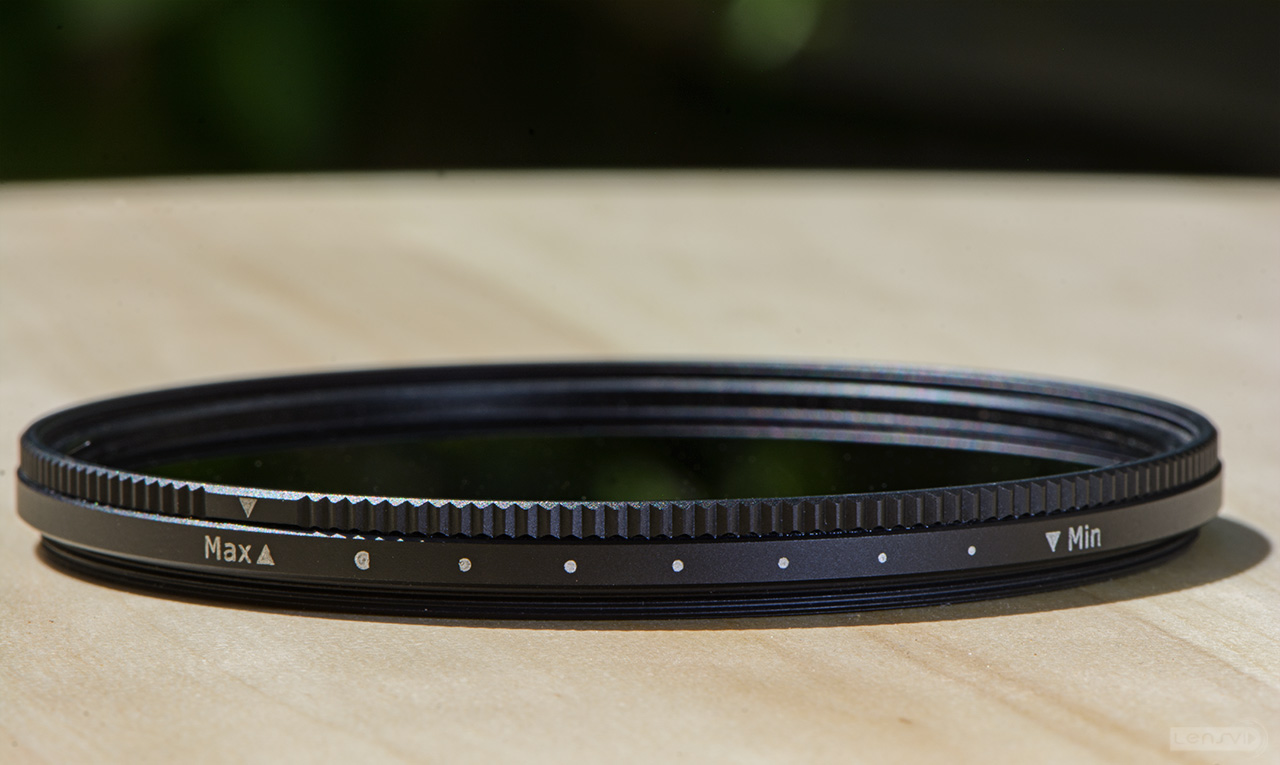 Note about long exposure in stills – With all the extensive testing that we did, there is one test that we didn’t perform (yet) and that is very long exposure in stills (water for example). We are aware of this and now that there might be some users who would like to buy this filter specifically for this type of use and we promise that we will add a some examples and a few words on that as soon as we can.
Note about long exposure in stills – With all the extensive testing that we did, there is one test that we didn’t perform (yet) and that is very long exposure in stills (water for example). We are aware of this and now that there might be some users who would like to buy this filter specifically for this type of use and we promise that we will add a some examples and a few words on that as soon as we can.
Table
We have looked at sharpness. colors, vignette and the dreaded x-factor – now it is time to look at the hard numbers and we have them all in one clear table:
 So what do we have here? we decided to write some points to make this simple, short and clear:
So what do we have here? we decided to write some points to make this simple, short and clear:
- The Power XND 2000 reduces much more light on its min level than the Syrp – 3.6 stops vs. 2/3 of a stop (good for when you really need to reduce light – not so much if you just need a bit of light reduction).
- Both filters have exactly the same variable light reduction – 4 stops (i.e. the amount of light reduction that you can “play” with by turning the filter). The only real difference is how much light reduction you start with.
- On both filters the max level is unusable in our view (although the Syrp don’t just have high levels of vignette but also color issues which makes it completely unusable around 8-8.5 lines on the filter).
- The Power XND 2000 is non linear just like the Syrp – you get very little light reduction early on and a lot close to the max. However, the Power XND 2000 only reduces light from 1/2 a second to 2 seconds (changing from 8 to max) while the Syrp goes way way down from 1/13 of a second to a full 1 second going from 8 to 8.5 as marked on the filter.
- Although the Power XND 2000 only has in our view around 7.5 usable stops of light reduction capability, is is still way better than the Syrp which has around 4.5 stops in our view (on the original Syrp article we mentioned about 6 – but the testing that we have done for this review made us reconsider this number).
Conclusion
So let’s sum things up. The Power XND 2000 promises to be the most powerful variable neutral density filter money can buy and to the best of our knowledge (and testing) it fulfils this promise.
Although you should not expect the full 11 stops of light reduction, you do get about 7.5 stops of useful light reduction capability with great sharpness, good colors (although we still need to check this more deeply over time), no “x-factor” and maybe most importantly very affordable price tag (from $70-$140 depending on the size).
On the downside the the Power XND 2000 comes with no case or step up rings and does have viable vignette (especially when getting close to the max).
High power variable neutral density filter – the Power XND 2000
 So what is our bottom line? Well, if you are looking for a very powerful light reduction filter and you need the ability to play with the exact levels – the Power XND 2000 is going to be a very good option (as long as you are O.K. with some vignetting). The only two things you really need to consider is that you have a minimum light reduction of about 3.5 stops just by putting the filter on your lens) and that if you really want long exposures in stills in mid day – you might still need a strong (non variable) ND filter.
So what is our bottom line? Well, if you are looking for a very powerful light reduction filter and you need the ability to play with the exact levels – the Power XND 2000 is going to be a very good option (as long as you are O.K. with some vignetting). The only two things you really need to consider is that you have a minimum light reduction of about 3.5 stops just by putting the filter on your lens) and that if you really want long exposures in stills in mid day – you might still need a strong (non variable) ND filter.
What we liked
- Very good image quality – no apparent reduction in sharpness/details (even sharper than the Syrp).
- Good build quality (with comfortable and smooth movement).
- Has no “X-factor” even at maximum ND.
What we liked less
- Doesn’t produce 11 stops of ND (just under 10 in our tests with about 7.5 stops usable in our opinion).
- Visible vignette thought the entire range of the filter.
- Fairly basic package (no case/step up rings).
You can check out more LensVid exclusive articles and reviews on the following link.

You can support LensVid by shopping with our affiliate partners
Affiliates: Amazon, B&H, Adorama and E-bay.
Why should you trust us?